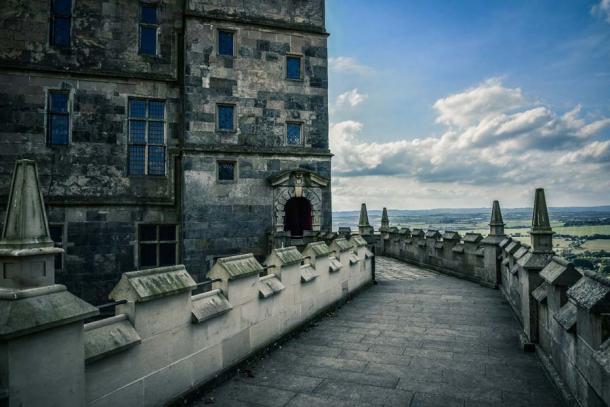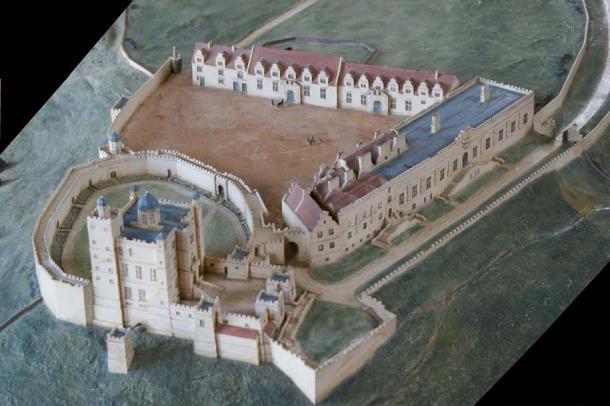
Bolsover Castle: 11th Century Fort Bloomed Into Stunning Residence
Bolsover Castle is a famous and unusual castle in Derbyshire, a county in England’s East Midlands. Although the current building was constructed during the 17th century, the history of Bolsover Castle stretches back to the 11th century. Whilst the original castle primarily served a defensive purpose, the 17th century one was constructed as a luxurious residence. The ownership of Bolsover Castle changed hands numerous times over the course of its history and was finally given to the nation in 1945. Today, Bolsover Castle is under the care of the English Heritage charity and is open to the public.

A closeup view of Bolsover Castle’s stonework and architectural design. (GetFocusStudio / Adobe Stock)
The Early Years of Bolsover Castle: High Defensive Stone Walls
In 1086, Bolsover manor was granted to William Peverel by the English king, William I. Peverel is rumored to have been the king’s illegitimate son. Subsequently, an earth and timber motte-and-bailey castle, the original Bolsover Castle, was built. The castle, being located on the edge of a promontory of land, gave the Perevels a commanding view of the surrounding countryside. When the Perevel family went extinct the 1150s, the castle was returned to the English Crown.
- Carlisle Castle: The Most Besieged Castle in Britain
- The Fascinating History of Medieval Castles: From Emergence to Obsoletion
During the late 12th and early 13th centuries, Bolsover Castle was rebuilt in stone. The defensive features of the new castle included a stone keep, and curtain walls with turrets. During the First Barons’ War, Bolsover Castle was besieged by William de Ferras, the Earl of Derby. The castle was damaged during this conflict but was soon repaired. In the centuries that followed, Bolsover Castle lost its importance, and gradually deteriorated into ruin.
In 1553, Bolsover Castle was bought by Sir George Talbot. Ownership of the castle changed again in 1608, when it was sold to Sir Charles Cavendish, who was the stepbrother and brother-in-law of Gilbert Talbot, George’s son. Cavendish’s purchase is a significant event in the history of Bolsover Castle, as he was responsible for the initiating the construction of the current castle.
Unlike previous owners, Cavendish did not focus on the defensive properties of Bolsover Castle. Instead, he intended to convert it into a luxurious palace. Under his direction, Bolsover Castle was rebuilt to serve as a retreat from Welbeck, the stronghold of the Cavendish family. Robert Smythson, an English architect, was employed for the rebuilding of Bolsover Castle.

The Little Castle at Bolsover Castle, built as a comfortable and elegant residence that was a major departure from the earlier defensive function of the site. (Tom Curtis / Adobe Stock)
Bolsover’s Little Castle: An Elegant and Comfortable Residence
The centerpiece of the new Bolsover Castle, known as the “Little Castle,” was built directly above the old keep. Whilst its exterior retained the form of the Norman keep, its interior was designed to be comfortable and elegant.
- The Dramatic and Bloody History of Nottingham Castle
- Blarney Castle: 1,000 Years of Dramatic History and THAT Magical Stone That Brings Tourists Flocking
The Little Castle was only completed in 1621, after the deaths of both Cavendish and Smythson. Nevertheless, the construction of the new castle was continued by William and John, the sons of Charles and Robert, respectively. Apart from completing the Little Castle, William also added the castle’s terrace, which was converted into a roofless ruin along one edge of the site.
During William’s lifetime the English Civil War broke out, thereby interrupting his ownership of Bolsover Castle. William was a Royalist, and when the Scots invaded England in support of the Parliament in 1644, he was ordered to intercept and destroy them. Later that year, William was one of the commanders at the Battle of Marston Moor, during which the Royalists were defeated by the Parliamentarians. Following this defeat, William fled England, and eventually ended up at the exiled court of Queen Henrietta Maria, the wife of Charles I in Paris.

A model of Bolsover Castle as it may have looked in the late 1600s. (Andrew Michaels / CC BY 2.0)
Parliamentarians and Royalists Battle Over Bolsover Castle
In the meantime, the Parliamentarians besieged Bolsover Castle. Since the castle was not actually meant to serve a defensive function, it immediately surrendered. Still, the Parliamentarians perceived the castle as a threat, and intended to have it demolished to prevent it from being used by the Royalists.
Fortunately for Bolsover Castle, it was saved from complete destruction by Charles, William’s brother, who paid a hefty fine, and re-purchased the property on behalf of his brother’s children. Nevertheless, the castle was stripped of whatever defensive features it had left.
William was only able to return to England in 1660, after the monarchy was restored. In addition to repairing Bolsover Castle, he also added the Riding House Range to the site. This is considered to be one of England’s most important equestrian facilities as it is one of the earliest riding houses in the country to have survived till this day.

The exterior of the long gallery at Bolsover Castle. (Andrew Knowles / CC BY 2.0)
From Vicarage to English Heritage Tourist Attraction
Following William’s death in 1676, Bolsover Castle passed into the hands of his son, Henry. Unlike his father, Henry cared less for the castle, which, consequently, went into decline. This decay continued for the next century, and by 1770, the terrace range had fallen into ruins. Subsequently, Bolsover Castle passed into the hands of the Dukes of Portland. For much of the 19th century, the castle was rented out, and used as a vicarage.
- Caernarfon Castle: The Imposing Welsh Constantinople
- Donegal Castle: Home of the O’Donnell Clan, Fort of the Foreigner, Captivating Gaelic Castle
In 1945, Bolsover Castle was donated to the nation by William Cavendish-Bentinck, the 7th Duke of Portland, and was repaired by the Ministry of Works. Subsequently, in 1984, Bolsover Castle came into the care of the English Heritage charity.
Today, Bolsover Castle is open to the public. Tickets are required for entrance into the castle, unless one is an English Heritage member. Special events, especially those related to horsemanship, are also organized at the castle for the enjoyment of its visitors.
Top image: Bolsover Castle and its grand view over Bolsover town and the surrounding landscape. Source: Matthew / Adobe Stock
By Wu Mingren
References
Bibby, M. & Craig-Johnson, E., 2021. Bolsover Castle, Derbyshire. [Online]
Available at: https://www.historic-uk.com/HistoryMagazine/DestinationsUK/Bolsover-Castle/
English Heritage, 2021. Bolsover Castle. [Online]
Available at: https://www.english-heritage.org.uk/visit/places/bolsover-castle/
www.britainirelandcastles.com, 2021. Castles of England - Bolsover Castle. [Online]
Available at: https://www.britainirelandcastles.com/England/Derbyshire/Bolsover-Castle...
www.castlesfortsbattles.co.uk, 2016. Bolsover Castle. [Online]
Available at: http://www.castlesfortsbattles.co.uk/midlands/bolsover_castle.html















